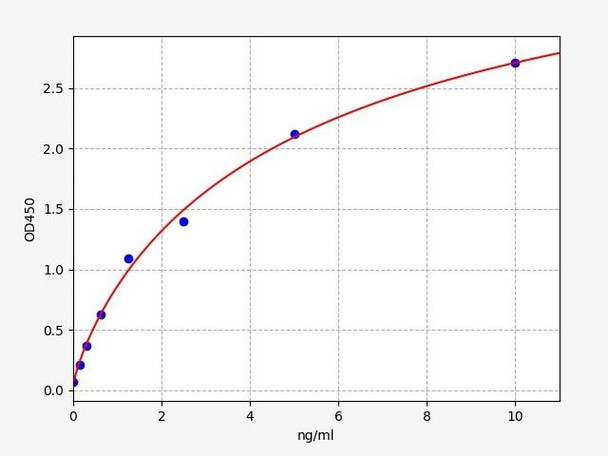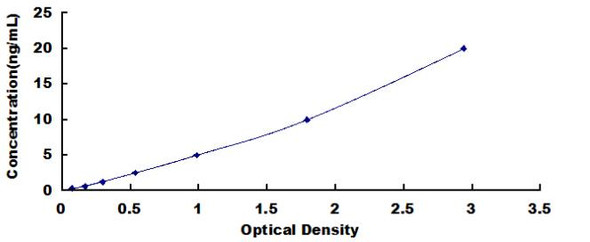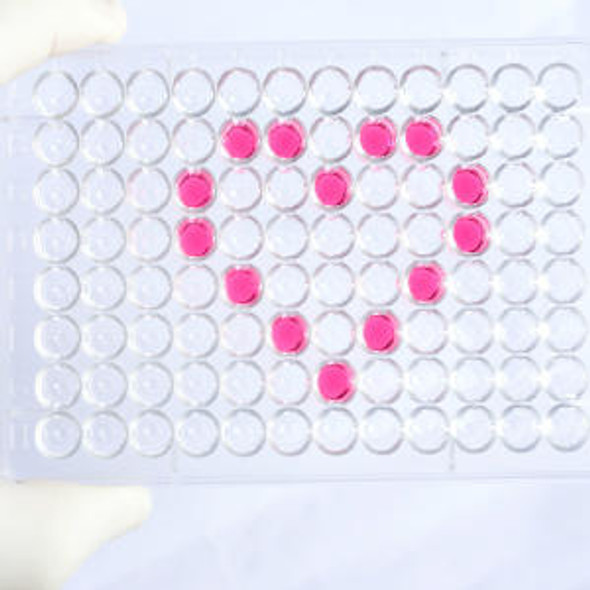Human Tspo (Translocator protein) ELISA Kit (HUFI03410)
- SKU:
- HUFI03410
- Product Type:
- ELISA Kit
- Size:
- 96 Assays
- Uniprot:
- P30536
- Sensitivity:
- 0.094ng/ml
- Range:
- 0.156-10ng/ml
- ELISA Type:
- Sandwich
- Synonyms:
- Translocator protein, Mitochondrial benzodiazepine receptor, PKBS, Peripheral-type benzodiazepine receptor, PBR, TSPO, BZRP, MBR
- Reactivity:
- Human
Description
Human Tspo (Translocator protein) ELISA Kit (HUFI03410)
The Human TSPO (Translocator Protein) ELISA Kit is a highly efficient and reliable tool for the quantitative detection of TSPO levels in human samples such as serum, plasma, and cell culture supernatants. With its high sensitivity and specificity, this kit delivers accurate results, making it suitable for various research applications.TSPO, also known as the translocator protein, is a key player in mitochondrial biology and has been implicated in numerous physiological and pathological processes.
It is involved in regulating cellular energy metabolism, steroid biosynthesis, and immune response, making it a valuable biomarker for studying conditions such as neuroinflammation, neurodegenerative diseases, and psychiatric disorders.Overall, the Human TSPO ELISA Kit offers researchers a precise and effective tool for investigating the role of TSPO in health and disease, providing insights that may lead to the development of new therapeutic strategies.
| Product Name: | Human Tspo (Translocator protein) ELISA Kit |
| Product Code: | HUFI03410 |
| Size: | 96 Assays |
| Alias: | Translocator protein ELISA Kit, Mitochondrial benzodiazepine receptor ELISA Kit, PKBS ELISA Kit, Peripheral-type benzodiazepine receptor ELISA Kit, PBR ELISA Kit, TSPO ELISA Kit, BZRP ELISA Kit, MBR ELISA Kit |
| Detection method: | Sandwich ELISA, Double Antibody |
| Application: | This immunoassay kit allows for the in vitro quantitative determination of Human Tspo (Translocator protein) concentrations in serum plasma and other biological fluids. |
| Sensitivity: | < 0.094ng/ml |
| Range: | 0.156-10ng/ml |
| Storage: | 4°C for 6 months |
| Note: | For Research Use Only |
| Recovery: | Matrices listed below were spiked with certain level of Human Tspo (Translocator protein) and the recovery rates were calculated by comparing the measured value to the expected amount of Human Tspo (Translocator protein) in samples. | ||||||||||||||||
| |||||||||||||||||
| Linearity: | The linearity of the kit was assayed by testing samples spiked with appropriate concentration of Human Tspo (Translocator protein) and their serial dilutions. The results were demonstrated by the percentage of calculated concentration to the expected. | ||||||||||||||||
| |||||||||||||||||
| CV(%): | Intra-Assay: CV<8% Inter-Assay: CV<10% |
| Component | Quantity | Storage |
| ELISA Microplate (Dismountable) | 8×12 strips | 4°C for 6 months |
| Lyophilized Standard | 2 | 4°C/-20°C |
| Sample/Standard Dilution Buffer | 20ml | 4°C |
| Biotin-labeled Antibody(Concentrated) | 120ul | 4°C (Protect from light) |
| Antibody Dilution Buffer | 10ml | 4°C |
| HRP-Streptavidin Conjugate(SABC) | 120ul | 4°C (Protect from light) |
| SABC Dilution Buffer | 10ml | 4°C |
| TMB Substrate | 10ml | 4°C (Protect from light) |
| Stop Solution | 10ml | 4°C |
| Wash Buffer(25X) | 30ml | 4°C |
| Plate Sealer | 5 | - |
Other materials and equipment required:
- Microplate reader with 450 nm wavelength filter
- Multichannel Pipette, Pipette, microcentrifuge tubes and disposable pipette tips
- Incubator
- Deionized or distilled water
- Absorbent paper
- Buffer resevoir
| UniProt Protein Function: | TSPO: Responsible for the manifestation of peripheral-type benzodiazepine recognition sites and is most likely to comprise binding domains for benzodiazepines and isoquinoline carboxamides. May play a role in the transport of porphyrins and heme. Plays a role in the transport of cholesterol across mitochondrial membranes in steroidogenic cells. Belongs to the TspO/BZRP family. Interacts with BZRAP1. May interact with STAR. Interacts with MOST-1. 2 isoforms of the human protein are produced by alternative splicing. |
| UniProt Protein Details: | Protein type:Mitochondrial; Receptor, misc.; Membrane protein, integral; Apoptosis; Membrane protein, multi-pass Chromosomal Location of Human Ortholog: 22q13.31 Cellular Component: cytoplasm; integral to membrane; intracellular membrane-bound organelle; mitochondrial outer membrane; mitochondrion; nuclear membrane Molecular Function:androgen binding; benzodiazepine receptor activity; cholesterol binding; protein binding Biological Process: adrenal gland development; aging; anion transport; apoptosis; axon regeneration in the peripheral nervous system; behavioral response to pain; cell proliferation; chloride transport; glial cell migration; heme biosynthetic process; lipid transport; negative regulation of nitric oxide biosynthetic process; negative regulation of protein ubiquitination; negative regulation of tumor necrosis factor production; positive regulation of apoptosis; positive regulation of calcium ion transport; positive regulation of mitochondrial depolarization; protein targeting to mitochondrion; regulation of cholesterol transport; regulation of steroid biosynthetic process; response to drug; response to manganese ion; response to progesterone stimulus; response to testosterone stimulus; response to vitamin B1; steroid biosynthetic process; steroid metabolic process |
| NCBI Summary: | Present mainly in the mitochondrial compartment of peripheral tissues, the protein encoded by this gene interacts with some benzodiazepines and has different affinities than its endogenous counterpart. The protein is a key factor in the flow of cholesterol into mitochondria to permit the initiation of steroid hormone synthesis. Alternatively spliced transcript variants have been reported; one of the variants lacks an internal exon and is considered non-coding, and the other variants encode the same protein. [provided by RefSeq, Feb 2012] |
| UniProt Code: | P30536 |
| NCBI GenInfo Identifier: | 313104268 |
| NCBI Gene ID: | 706 |
| NCBI Accession: | P30536.3 |
| UniProt Secondary Accession: | P30536,Q53Y59, Q6ICF9, Q96TF6, |
| UniProt Related Accession: | P30536 |
| Molecular Weight: | 10,537 Da |
| NCBI Full Name: | Translocator protein |
| NCBI Synonym Full Names: | translocator protein |
| NCBI Official Symbol: | TSPO |
| NCBI Official Synonym Symbols: | DBI; IBP; MBR; PBR; PBS; BPBS; BZRP; PKBS; PTBR; mDRC; pk18 |
| NCBI Protein Information: | translocator protein |
| UniProt Protein Name: | Translocator protein |
| UniProt Synonym Protein Names: | Mitochondrial benzodiazepine receptor; PKBS; Peripheral-type benzodiazepine receptor; PBR |
| UniProt Gene Name: | TSPO |
| UniProt Entry Name: | TSPOA_HUMAN |
*Note: Protocols are specific to each batch/lot. For the correct instructions please follow the protocol included in your kit.
Before adding to wells, equilibrate the SABC working solution and TMB substrate for at least 30 min at 37 °C. When diluting samples and reagents, they must be mixed completely and evenly. It is recommended to plot a standard curve for each test.
| Step | Protocol |
| 1. | Set standard, test sample and control (zero) wells on the pre-coated plate respectively, and then, record their positions. It is recommended to measure each standard and sample in duplicate. Wash plate 2 times before adding standard, sample and control (zero) wells! |
| 2. | Aliquot 0.1ml standard solutions into the standard wells. |
| 3. | Add 0.1 ml of Sample / Standard dilution buffer into the control (zero) well. |
| 4. | Add 0.1 ml of properly diluted sample ( Human serum, plasma, tissue homogenates and other biological fluids.) into test sample wells. |
| 5. | Seal the plate with a cover and incubate at 37 °C for 90 min. |
| 6. | Remove the cover and discard the plate content, clap the plate on the absorbent filter papers or other absorbent material. Do NOT let the wells completely dry at any time. Wash plate X2. |
| 7. | Add 0.1 ml of Biotin- detection antibody working solution into the above wells (standard, test sample & zero wells). Add the solution at the bottom of each well without touching the side wall. |
| 8. | Seal the plate with a cover and incubate at 37 °C for 60 min. |
| 9. | Remove the cover, and wash plate 3 times with Wash buffer. Let wash buffer rest in wells for 1 min between each wash. |
| 10. | Add 0.1 ml of SABC working solution into each well, cover the plate and incubate at 37 °C for 30 min. |
| 11. | Remove the cover and wash plate 5 times with Wash buffer, and each time let the wash buffer stay in the wells for 1-2 min. |
| 12. | Add 90 µL of TMB substrate into each well, cover the plate and incubate at 37 °C in dark within 10-20 min. (Note: This incubation time is for reference use only, the optimal time should be determined by end user.) And the shades of blue can be seen in the first 3-4 wells (with most concentrated standard solutions), the other wells show no obvious color. |
| 13. | Add 50 µL of Stop solution into each well and mix thoroughly. The color changes into yellow immediately. |
| 14. | Read the O.D. absorbance at 450 nm in a microplate reader immediately after adding the stop solution. |
When carrying out an ELISA assay it is important to prepare your samples in order to achieve the best possible results. Below we have a list of procedures for the preparation of samples for different sample types.
| Sample Type | Protocol |
| Serum | If using serum separator tubes, allow samples to clot for 30 minutes at room temperature. Centrifuge for 10 minutes at 1,000x g. Collect the serum fraction and assay promptly or aliquot and store the samples at -80°C. Avoid multiple freeze-thaw cycles. If serum separator tubes are not being used, allow samples to clot overnight at 2-8°C. Centrifuge for 10 minutes at 1,000x g. Remove serum and assay promptly or aliquot and store the samples at -80°C. Avoid multiple freeze-thaw cycles. |
| Plasma | Collect plasma using EDTA or heparin as an anticoagulant. Centrifuge samples at 4°C for 15 mins at 1000 × g within 30 mins of collection. Collect the plasma fraction and assay promptly or aliquot and store the samples at -80°C. Avoid multiple freeze-thaw cycles. Note: Over haemolysed samples are not suitable for use with this kit. |
| Urine & Cerebrospinal Fluid | Collect the urine (mid-stream) in a sterile container, centrifuge for 20 mins at 2000-3000 rpm. Remove supernatant and assay immediately. If any precipitation is detected, repeat the centrifugation step. A similar protocol can be used for cerebrospinal fluid. |
| Cell culture supernatant | Collect the cell culture media by pipette, followed by centrifugation at 4°C for 20 mins at 1500 rpm. Collect the clear supernatant and assay immediately. |
| Cell lysates | Solubilize cells in lysis buffer and allow to sit on ice for 30 minutes. Centrifuge tubes at 14,000 x g for 5 minutes to remove insoluble material. Aliquot the supernatant into a new tube and discard the remaining whole cell extract. Quantify total protein concentration using a total protein assay. Assay immediately or aliquot and store at ≤ -20 °C. |
| Tissue homogenates | The preparation of tissue homogenates will vary depending upon tissue type. Rinse tissue with 1X PBS to remove excess blood & homogenize in 20ml of 1X PBS (including protease inhibitors) and store overnight at ≤ -20°C. Two freeze-thaw cycles are required to break the cell membranes. To further disrupt the cell membranes you can sonicate the samples. Centrifuge homogenates for 5 mins at 5000xg. Remove the supernatant and assay immediately or aliquot and store at -20°C or -80°C. |
| Tissue lysates | Rinse tissue with PBS, cut into 1-2 mm pieces, and homogenize with a tissue homogenizer in PBS. Add an equal volume of RIPA buffer containing protease inhibitors and lyse tissues at room temperature for 30 minutes with gentle agitation. Centrifuge to remove debris. Quantify total protein concentration using a total protein assay. Assay immediately or aliquot and store at ≤ -20 °C. |
| Breast Milk | Collect milk samples and centrifuge at 10,000 x g for 60 min at 4°C. Aliquot the supernatant and assay. For long term use, store samples at -80°C. Minimize freeze/thaw cycles. |










